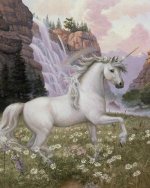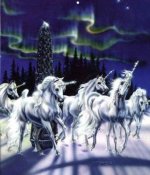♘امیرحسین♞
♘ مدیریت انجمن اسب ایران ♞
In its origins, the Unicorn was a creature depicted as a white horse, with antelope hooves, billy-goat beard, and a horn in its forehead.
But with the pass of time, fantasy artists have depicted the Unicorn as a horse with a horn in its forehead and lacking of the other elements. Some also depict the Unicorn winged.
There are ancient Greek, Roman, and Macedonian stories that tell about a creature with a single horn.
Some say that the origin of those stories may lay in the travels that they did into the India, and they are describing the Indian rhinoceros.
Other origins of the Unicorn can be found in the viking mythology and tell about a sea creature that has a horn in its forehead and probably it's actually a cetacean called narval.
But both the narval and the rhinoceros are very different from a horse with a horn in its forehead.
One of the first versions about the Unicorn is the one that the Greek physician Ctesias did in 400 B.C., in one of the expeditions to India. He talks about a white animal with the body of a horse...
He also talks about its distrustful and lonely nature.
Then, the belief in the protective power of the Unicorn's horn against poison and diseases is born. And it becomes a synonym of a long life.
There's another reference to the Unicorn in the Greek mythology. It is said that Zeus was fed by a goat called Amalthea. In some stories, that animal that feeds Zeus is not a goat but an Unicorn.
The legend says that one day, Zeus broke the horn of Amalthea and a big amount of food emerged from that horn, that was called The Horn Of Abundance. Zeus rewarded Amalthea turning it into the star Capella.
Aristotle wrote about the Unicorn, and also Julius Caesar in "Bellum Gallicum" (50 BC).
In the Middle Ages, the Unicorns are the symbol of purity, and in some religious artworks they are linked to Christianity.
It was said that only the young female virgins can approach an Unicorn. So in the Middle Ages, the headhunters used virgins to try catch an Unicorn, and get its valuable horn.
The belief in the Unicorn was also present in Asia. In Japan, it was called Kirin, and symbolizes the Justice.
In Persia it was called Shadhavar, and the Unicorn is similar to a gazelle with a single horn. The horn has holes, and when the wind blows, it sounds like a flute. Animals and humans are attracted by its music, and when they are near, the Shadhavar attacks them. This is the reason why this mythical animal is symbol of temptation and danger, in Persia.
In China, the Unicorn (Qilin) is symbol of wisdom, and is classified like the king of all animals. There's a legend in China that says that a king was sat close to a river, and an Unicorn appeared. It had magic symbols in the back, and they helped the king to create the first Chinese writings.
Some adventurers that in the XVIII century traveled to Tibet, said that the fabulous creatures called Unicorns really existed in that place.
In all these stories and legends there's something in common: the spirit of a mythical animal of exceptional beauty, purity, and nobleness.
But with the pass of time, fantasy artists have depicted the Unicorn as a horse with a horn in its forehead and lacking of the other elements. Some also depict the Unicorn winged.
There are ancient Greek, Roman, and Macedonian stories that tell about a creature with a single horn.
Some say that the origin of those stories may lay in the travels that they did into the India, and they are describing the Indian rhinoceros.
Other origins of the Unicorn can be found in the viking mythology and tell about a sea creature that has a horn in its forehead and probably it's actually a cetacean called narval.
But both the narval and the rhinoceros are very different from a horse with a horn in its forehead.
One of the first versions about the Unicorn is the one that the Greek physician Ctesias did in 400 B.C., in one of the expeditions to India. He talks about a white animal with the body of a horse...
He also talks about its distrustful and lonely nature.
Then, the belief in the protective power of the Unicorn's horn against poison and diseases is born. And it becomes a synonym of a long life.
There's another reference to the Unicorn in the Greek mythology. It is said that Zeus was fed by a goat called Amalthea. In some stories, that animal that feeds Zeus is not a goat but an Unicorn.
The legend says that one day, Zeus broke the horn of Amalthea and a big amount of food emerged from that horn, that was called The Horn Of Abundance. Zeus rewarded Amalthea turning it into the star Capella.
Aristotle wrote about the Unicorn, and also Julius Caesar in "Bellum Gallicum" (50 BC).
In the Middle Ages, the Unicorns are the symbol of purity, and in some religious artworks they are linked to Christianity.
It was said that only the young female virgins can approach an Unicorn. So in the Middle Ages, the headhunters used virgins to try catch an Unicorn, and get its valuable horn.
The belief in the Unicorn was also present in Asia. In Japan, it was called Kirin, and symbolizes the Justice.
In Persia it was called Shadhavar, and the Unicorn is similar to a gazelle with a single horn. The horn has holes, and when the wind blows, it sounds like a flute. Animals and humans are attracted by its music, and when they are near, the Shadhavar attacks them. This is the reason why this mythical animal is symbol of temptation and danger, in Persia.
In China, the Unicorn (Qilin) is symbol of wisdom, and is classified like the king of all animals. There's a legend in China that says that a king was sat close to a river, and an Unicorn appeared. It had magic symbols in the back, and they helped the king to create the first Chinese writings.
Some adventurers that in the XVIII century traveled to Tibet, said that the fabulous creatures called Unicorns really existed in that place.
In all these stories and legends there's something in common: the spirit of a mythical animal of exceptional beauty, purity, and nobleness.




